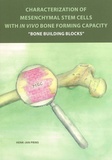Characterization of Mesenchymal Stem Cells with In Vivo Bone Forming Capacity
“Bone Building Blocks”

Prins, Henk-Jan
- Promoter:
- Prof.dr. P.J. (Paul) Coffer
- Co-promoter:
- Dr A.C.M. (Anton) Martens & dr H. (Henk) Rozemuller
- Research group:
- Coffer
- Date:
- October 13, 2011
- Time:
- 12:15 h
Summary
This thesis describes the investigation of the characteristics of cultured MSC with a special focus on the MSCs with in vivo bone forming capacity. The most relevant contributions of the work described in this thesis to the field of regenerative medicine, and bone tissue engineering research field in particular, are the following: 1) The identification of novel cross-reacting monoclonal antibodies for prospective isolation of primary MSCs (with clonogenic potential) from multiple mammalian species that are widely used in regenerative medicine research; 2)We investigated the use of human platelet lysate (PL) for MSC expansion as a substitute for fetal bovine serum (FBS). Use of PL enables MSCs expansion under GMP conditions in a relatively short time period, retaining a common phenotype and multipotency. This procedure is relevant for clinical applications that require high numbers of MSCs, such as in the treatment for graft-versus-host disease, Crohn’s disease, and rheumatoid arthritis; 3) We observed that, in contrast to FBS, culturing MSCs in human PL results in the production of MSCs with a more predictable capacity for in vivo bone formation, which is highly relevant for standardized MSC-based bone tissue engineering; 4) The analysis of clonally PL expanded MSC cultures revealed heterogeneity in in vitro characteristics as well as in in vivo bone formation, which is highly relevant for cell-based bone tissue engineering, and presumably also for other MSC-based tissue engineering applications; 5) For the prediction of the in vivo bone forming capacity of a given MSC batch, it is not the absolute ALP activity/expression, but the capacity to induce the ALP activity in clonally PL expanded MSCs, that is the relevant parameter; 6) Bioluminescent imaging (BLI) can be used to monitor human as well as goat MSC survival during in vivo bone formation; 7) The presence of a scaffold only, or MSC matrix alone is not enough to initiate ectopic bone formation by endogenous MSCs; 8) Seeded MSCs contribute to in vivo bone formation as evidenced by the presence of gene marked human as well as goat MSCs six weeks post implantation. In hybrid scaffolds, the MSC contribute to the initiation and participate in new bone formation by differentiating towards osteoblasts and osteocytes in vivo; 9) The superior characteristics of β-tricalcium phosphate (TCP) over hydroxyapatite in forming bone can not only be explained by the calcium-enriched environment provided by porous TCP, but also to the spatial distribution, location and structured binding of the implanted MSCs to their scaffold, which is critical in cell/scaffold bone tissue engineering; 10) The in vivo bone forming assay that we developed enables us to reproducibly create scaffolds with a high content of human bone using PL expanded MSCs. This was crucial in the development of a novel humanized multiple myeloma (MM) mouse model. Human MM heavily depends on the presence of a (human) bone microenvironment and therefore this model provide excellent opportunities to study the pathology of MM in its natural bone environment, and use it for preclinical therapy development.